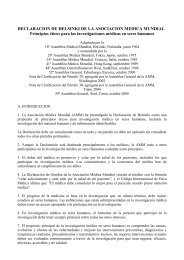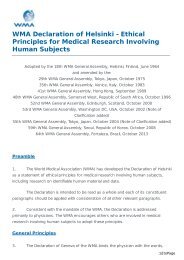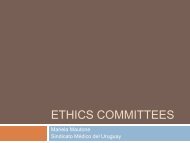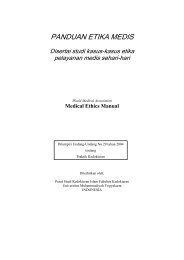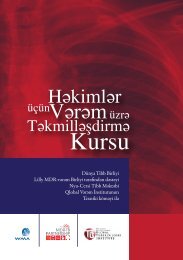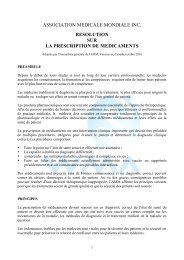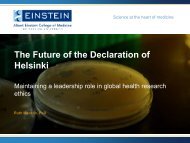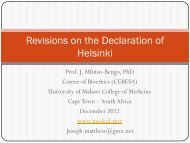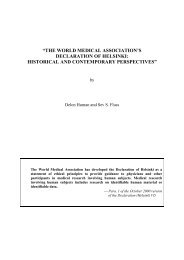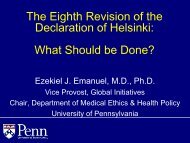WMJ 03 2010 - World Medical Association
WMJ 03 2010 - World Medical Association
WMJ 03 2010 - World Medical Association
- No tags were found...
Create successful ePaper yourself
Turn your PDF publications into a flip-book with our unique Google optimized e-Paper software.
<strong>Medical</strong> Ethics, Humam Rights, Socio-medical affairs and Environmental Policy<br />
friend of Jefferson’s. The letter proves that,<br />
as early as the beginning of the 19 th century,<br />
physicians consciously used the placebo effect<br />
while being aware of the ethical implications<br />
(“pious fraud”). During <strong>World</strong> War<br />
I a Jesuit priest employed as a nurse in a<br />
battlefield hospital, knowingly administered<br />
sodium chloride injections as placebos:<br />
“Every evening there was the fight about<br />
the morphine that the patients demanded.<br />
They begged and pleaded. But we used it<br />
sparingly and, if it was at all possible, we<br />
did not give them any. [...] If the lamenting<br />
did not cease we often had no choice but<br />
deceive them with a sodium chloride injection.<br />
The moaning and groaning often continued<br />
all through the night [...].”[Archives<br />
of the German Jesuit Province in Munich,<br />
00/752vl, Kriegslazarett 8, vol. 1-2. P. 126]<br />
The placebo in clinical research<br />
The beginnings of the controlled trial<br />
(with simple, double and triple blinding)<br />
date back to the 18 th century, though no<br />
placebo was used to start with. It began<br />
with the Scottish Naval Surgeon James<br />
Lind (1716–1794) [43]. In his Treatise on<br />
the Scurvy (1753) he described how he performed<br />
the first clinical drug testing on 20<br />
May 1747 on board a British Navy vessel.<br />
Of 12 scurvy patients (“as similar as I could<br />
have them”) two were given cider, two vitriol,<br />
two vinegar, two sea water, two oranges<br />
and lemons, two an electuary of garlic,<br />
mustard seeds, balsam of Peru and gum<br />
myrrh. The patients who were fed citrus<br />
fruit recovered within six days. The comparison<br />
group remained without treatment<br />
apart from “a little lenitive electuary”[32].<br />
We know today that citrus fruits are the<br />
treatment of choice because they contain<br />
vitamin C the lack of which causes scurvy.<br />
As the vitamins had not been discovered<br />
yet at the time, lemon juice was seen as a<br />
cleansing agent that could rid the body of<br />
toxic particles. In 1784, a commission of<br />
experts that was appointed by the French<br />
king, Louis XVI (1754–1793), and included<br />
Benjamin Franklin (1706–1790), carried<br />
out simple blind trials to ascertain whether<br />
Franz Anton Mesmer (1734–1815) was<br />
right in claiming that the magnetic fluid<br />
(animal magnetism) had a healing effect.<br />
For the trial, the test candidates were separated<br />
from the physician, who was to mesmerize<br />
them, by a screen. The fluid transfer<br />
only worked if the test person knew about<br />
the treatment which led the commission to<br />
conclude in 1785: “this agent, this fluid has<br />
no existence”[27]. This by no means put<br />
an end to the debate about the effectiveness<br />
and effect of mesmerism. It continued<br />
right into the 19 th century and there are<br />
still magnetisers today who see themselves<br />
as continuing Mesmer’s legacy [26, 42].<br />
In 1799, the British physician Dr John<br />
Haygarth (1740–1827) tested in a simple<br />
blinded trial the controversial healing approach<br />
of the American doctor Elisha Perkins<br />
(1741–1799) who claimed he could<br />
deviate harmful energy (electroid fluid)<br />
from the sick body by means of a “tractor”<br />
made from two metal rods [19]. The test<br />
was performed in the following way: there<br />
were two groups, one of which was treated<br />
with the metal tractors and the other with<br />
wooden rods that were made to look exactly<br />
like the “genuine” ones. The treatment was<br />
similarly successful in both groups.<br />
The first controlled clinical trials with “inert”<br />
substances were developed by physicians<br />
who either sought to prove the effectiveness<br />
of homeopathy or to expose this<br />
new healing system as “humbug” [11, 12].<br />
The first was the German-Russian physician<br />
Dr J. Hermann who, in 1829, performed a<br />
kind of outcome study in a military hospital<br />
in Tulchin, now Ukraine. He compared<br />
the treatment of malaria patients in a homeopathic<br />
and an allopathic ward [20]. In<br />
a follow up trial, which he was able to conduct<br />
shortly after in a military hospital in<br />
St Petersburg under the supervision of a<br />
Dr Gigler, a third trial arm was added. The<br />
patients allocated to this group basically<br />
received only general care (baths, sufficient<br />
food and rest):<br />
“During that time the patients were kept<br />
in a state of innocent deception. In order to<br />
avoid the suspicion that they did not receive<br />
any medicine, they were prescribed pills<br />
made from white bread crumbs or cocoa, or<br />
sugar of milk powder, or salep decoctions as<br />
was also the case in the homeopathic ward”<br />
[31].<br />
Interestingly, the best results were achieved<br />
in the group that was given no treatment<br />
apart from loving care.<br />
The first double blind trial with a placebo<br />
arm also served the assessment of homeopathy.<br />
The initiative by physicians who were<br />
sceptical about homeopathy took place in a<br />
Nuremberg public house in 1835 [Stolberg,<br />
1996]. The trial was performed as follows:<br />
A C30 solution of purified salt and distilled<br />
snow water was prepared. 100 vials were<br />
meticulously cleaned and numbered, then<br />
well shuffled and spread on two tables. Half<br />
of them were filled with the homeopathic<br />
solution, the other with pure distilled snow<br />
water. After a list of the vials and their con-<br />
111



